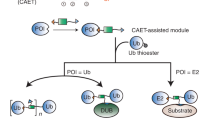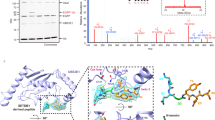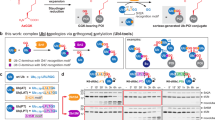Abstract
Small ubiquitin-like modifier (SUMO) post-translational modification (PTM) of proteins has a crucial role in the regulation of important cellular processes. This protocol describes the chemical synthesis of functional SUMO–peptide conjugates. The two crucial stages of this protocol are the solid-phase synthesis of peptide segments derivatized by thioester or bis(2-sulfanylethyl)amido (SEA) latent thioester functionalities and the one-pot assembly of the SUMO–peptide conjugate by a sequential native chemical ligation (NCL)/SEA native peptide ligation reaction sequence. This protocol also enables the isolation of a SUMO SEA latent thioester, which can be attached to a target peptide or protein in a subsequent step. It is compatible with 9-fluorenylmethoxycarbonyl (Fmoc) chemistry, and it gives access to homogeneous, reversible and functional SUMO conjugates that are not easily produced using living systems. The synthesis of SUMO–peptide conjugates on a milligram scale takes 20 working days.
This is a preview of subscription content, access via your institution
Access options
Subscribe to this journal
Receive 12 print issues and online access
$259.00 per year
only $21.58 per issue
Buy this article
- Purchase on Springer Link
- Instant access to full article PDF
Prices may be subject to local taxes which are calculated during checkout




Similar content being viewed by others
References
Fierz, B. et al. Histone H2B ubiquitylation disrupts local and higher-order chromatin compaction. Nat. Chem. Biol. 7, 113–119 (2011).
Siman, P. et al. Convergent chemical synthesis of histone H2B protein for the site-specific ubiquitination at Lys34. Angew. Chem. Int. Ed. Engl. 52, 8059–8063 (2013).
Spasser, L. & Brik, A. Chemistry and biology of the ubiquitin signal. Angew. Chem. Int. Ed. Engl. 51, 6840–6862 (2012).
Kumar, K.S. et al. Total chemical synthesis of di-ubiquitin chains. Angew. Chem. Int. Ed. Engl. 49, 9126–9131 (2011).
Kumar, K.S. et al. Total chemical synthesis of a 304-amino acid K48-linked tetraubiquitin protein. Angew. Chem. Int. Ed. Engl. 50, 6137–6141 (2011).
Dawson, P.E., Muir, T.W., Clark-Lewis, I. & Kent, S.B. Synthesis of proteins by native chemical ligation. Science 266, 776–779 (1994).
Kent, S.B. Total chemical synthesis of proteins. Chem. Soc. Rev. 38, 338–351 (2009).
Merrifield, R.B. Solid-phase peptide synthesis. I. The synthesis of a tetrapeptide. J. Am. Chem. Soc. 85, 2149–2154 (1963).
Coin, I., Beyermann, M. & Bienert, M. Solid-phase peptide synthesis: from standard procedures to the synthesis of difficult sequences. Nat. Protoc. 2, 3247–3256 (2007).
El Oualid, F. et al. Chemical synthesis of ubiquitin, ubiquitin-based probes, and diubiquitin. Angew. Chem. Int. Ed. Engl. 49, 10149–10153 (2010).
Erlich, L.A. et al. N-methylcysteine-mediated total chemical synthesis of ubiquitin thioester. Org. Biomol. Chem. 8, 2392–2396 (2010).
Mende, F. & Seitz, O. 9-Fluorenylmethoxycarbonyl-based solid-phase synthesis of peptide α-thioesters. Angew. Chem. Int. Ed. Engl. 50, 1232–1240 (2011).
Zheng, J.-S., Tang, S., Huang, Y.-C. & Liu, L. Development of new thioester equivalents for protein chemical synthesis. Acc. Chem. Res. 46, 2475–2484 (2013).
Van Treel, N.D. & Mootz, H.D. SUMOylated RanGAP1 prepared by click chemistry. J. Pept. Sci. 20, 121–127 (2013).
Sommer, S. et al. Expanded click conjugation of recombinant proteins with ubiquitin-like modifiers reveals altered substrate preference of SUMO2-modified Ubc9. Angew. Chem. Int. Ed. Engl. 50, 9888–9892 (2011).
Boll, E. et al. A novel PEG-based solid support enables the synthesis of >50 amino-acid peptide thioesters and the total synthesis of a functional SUMO-1–peptide conjugate. Chem. Sci. 5, 2017–2022 (2014).
Ollivier, N. et al. Bis(2-sulfanylethyl)amino native peptide ligation. Org. Lett. 12, 5238–5241 (2010).
Hou, W., Zhang, X., Li, F. & Liu, C.F. Peptidyl N,N-bis(2-mercaptoethyl)-amides as thioester precursors for native chemical ligation. Org. Lett. 13, 386–389 (2011).
Raibaut, L., Ollivier, N. & Melnyk, O. Sequential native peptide ligation strategies for total chemical protein synthesis. Chem. Soc. Rev. 41, 7001–7015 (2012).
Ollivier, N. et al. A one-pot three-segment ligation strategy for protein chemical synthesis. Angew. Chem. Int. Ed. Engl. 51, 209–213 (2012).
Raibaut, L. et al. Highly efficient solid phase synthesis of large polypeptides by iterative ligations of bis(2-sulfanylethyl)amido (SEA) peptide segments. Chem. Sci. 4, 4061–4066 (2013).
Johnson, E.C. & Kent, S.B. Insights into the mechanism and catalysis of the native chemical ligation reaction. J. Am. Chem. Soc. 128, 6640–6646 (2006).
Li, S.J. & Hochstrasser, M. A new protease required for cell-cycle progression in yeast. Nature 398, 246–251 (1999).
Ollivier, N. et al. Tidbits for the synthesis of bis(2-sulfanylethyl)amido (SEA) polystyrene resin, SEA peptides and peptide thioesters. J. Pept. Sci. 20, 92–97 (2013).
Dheur, J., Ollivier, N., Vallin, A. & Melnyk, O. Synthesis of peptide alkylthioesters using the intramolecular N,S-acyl shift properties of bis(2-sulfanylethyl)amido peptides. J. Org. Chem. 76, 3194–3202 (2011).
Raibaut, L., Seeberger, P. & Melnyk, O. Bis(2-sulfanylethyl)amido peptides enable native chemical ligation at proline and minimize deletion side-product formation. Org. Lett. 15, 5516–5519 (2013).
Ancot, F. et al. Shedding-generated Met receptor fragments can be routed to either the proteasomal or the lysosomal degradation pathway. Traffic 13, 1261–1272 (2012).
Raibaut, L. et al. Total synthesis of biotinylated N domain of human hepatocyte growth factor. Bioorg. Med. Chem. 21, 3486–3494 (2013).
Garcia-Martin, F. et al. ChemMatrix, a poly(ethylene glycol)-based support for the solid-phase synthesis of complex peptides. J. Comb. Chem. 8, 213–220 (2006).
Carpino, L.A. 1-Hydroxy-7-azabenzotriazole: an efficient peptide coupling additive. J. Am. Chem. Soc. 115, 4397–4398 (1993).
Bang, D. & Kent, S.B. A one-pot total synthesis of crambin. Angew. Chem. Int. Ed. Engl. 43, 2534–2538 (2004).
Tan, Z., Shang, S. & Danishefsky, S.J. Insights into the finer issues of native chemical ligation: an approach to cascade ligations. Angew. Chem. Int. Ed. Engl. 49, 9500–9503 (2010).
Ueda, S. et al. Photolabile protection for one-pot sequential native chemical ligation. Chembiochem 6, 1983–1986 (2005).
Bang, D., Pentelute, B.L. & Kent, S.B. Kinetically controlled ligation for the convergent chemical synthesis of proteins. Angew. Chem. Int. Ed. Engl. 45, 3985–3988 (2006).
Zheng, J.S. et al. Chemical protein synthesis by kinetically controlled ligation of peptide O-esters. Chembiochem 11, 511–515 (2010).
Sato, K. et al. N-sulfanylethylanilide peptide as a crypto-thioester peptide. Chembiochem 12, 1840–1844 (2011).
Okamoto, R., Morooka, K. & Kajihara, Y. A synthetic approach to a peptide alpha-thioester from an unprotected peptide through cleavage and activation of a specific peptide bond by N-acetylguanidine. Angew. Chem. Int. Ed. Engl. 51, 191–196 (2012).
Fang, G.-M. et al. Protein chemical synthesis by ligation of peptide hydrazides. Angew. Chem. Int. Ed. Engl. 50, 7645–7649 (2011).
Zheng, J.-S. et al. Chemical synthesis of proteins using peptide hydrazides as thioester surrogates. Nat. Protoc. 8, 2483–2495 (2013).
Yang, R. et al. Dual native chemical ligation at lysine. J. Am. Chem. Soc. 131, 13592–13593 (2009).
Yang, R. et al. Synthesis of K48-linked diubiquitin using dual native chemical ligation at lysine. Chem. Commun. 46, 7199–7201 (2010).
Greenfield, N. & Fasman, G.D. Computed circular dichroism spectra for the evaluation of protein conformation. Biochemistry 8, 4108–4116 (1969).
Bayer, P. et al. Structure determination of the small ubiquitin-related modifier SUMO-1. J. Mol. Biol. 280, 275–286 (1998).
Muller, S., Hoege, C., Pyrowolakis, G. & Jentsch, S. SUMO, ubiquitin's mysterious cousin. Nat. Rev. Mol. Cell Biol. 2, 202–210 (2001).
Melnyk, O. & Agouridas, V. Perhydro-1,2,5-dithiazepine. e-EROS http://dx.doi.org/10.1002/047084289X.rn01723 (20 October 2014).
Vojkovsky, T. Detection of secondary amines on solid phase. Pept. Res. 8, 236–237 (1995).
Kaiser, E., Colescot, R.L., Bossinge, C.D. & Cook, P.I. Color test for detection of free terminal amino groups in solid-phase synthesis of peptides. Anal. Biochem. 34, 595–598 (1970).
Hancock, W.S. & Battersby, J.E. A new micro-test for the detection of incomplete coupling reactions in solid-phase peptide synthesis using 2,4,6-trinitrobenzenesulphonic acid. Anal. Biochem. 71, 260–264 (1976).
Yung, A., Papworth-Smith, J. & Wilkinson, S.M. Occupational contact urticaria from the solid-phase peptide synthesis coupling agents HATU and HBTU. Contact Dermatitis 49, 108–109 (2003).
Dheur, J., Ollivier, N. & Melnyk, O. Synthesis of thiazolidine thioester peptides and acceleration of native chemical ligation. Org. Lett. 13, 1560–1563 (2011).
Mutter, M. et al. Pseudo-prolines (psi Pro) for accessing 'inaccessible' peptides. Pept. Res. 8, 145–153 (1995).
Haack, T. & Mutter, M. Serine-derived oxazolidines as secondary structure disrupting, solubilizing building blocks in peptide synthesis. Tetrahedron Lett. 33, 1589–1592 (1992).
Wôhr, T. & Mutter, M. Pseudo-prolines in peptide synthesis: direct insertion of serine and threonine derived oxazolidines in dipeptides. Tetrahedron Lett. 36, 3847–3848 (1995).
Johnson, T., Quibell, M., Owen, D. & Sheppard, R.C. A reversible protecting group for the amide bond in peptides. Use in the synthesis of 'difficult sequences'. J. Chem. Soc. Chem. Commun. 369–372 (1993).
Ball, H.L. et al. Engineering the prion protein using chemical synthesis. J. Pept. Res. 58, 357–374 (2001).
Cardona, V. et al. Application of Dmb-dipeptides in the Fmoc SPPS of difficult and aspartimide-prone sequences. Int. J. Pept. Res. Ther. 14, 285–292 (2008).
Bourel, L., Carion, O., Gras-Masse, H. & Melnyk, O. The deprotection of Lys(Mtt) revisited. J. Pept. Sci. 6, 264–270 (2000).
Alnabari, M. & Bittner, S. Quinonic enaminones; Synthesis of new dialkylaminovinyl and bis(dialkylaminovinyl) derivatives of quinones. Synthesis 8, 1087–1090 (2000).
Alnabari, M. & Bittner, S. New quinone-amino acid conjugates linked via a vinylic spacer. Amino Acids 20, 381–387 (2001).
Ellman, G.L. A colorimetric method for determining low concentrations of mercaptans. Arch. Biochem. Biophys. 74, 443–450 (1958).
Acknowledgements
This study was supported by the Centre National de la Recherche Scientifique (CNRS), the University of Lille, Institut Pasteur de Lille and the Site de Recherche Intégrée sur le Cancer (SIRIC) OncoLille.
Author information
Authors and Affiliations
Contributions
O.M. designed and led the project. H.D., N.O., A.B., L.R., R.D. and J.V. conducted the experiments; E.B. conducted the experiment and co-wrote the manuscript with O.M.
Corresponding author
Ethics declarations
Competing interests
O.M. is cofounder of X'ProChem company.
Integrated supplementary information
Supplementary Figure 1 HPLC chromatogram, ESI and MALDI-TOF spectra for purified SEAoff peptide segment 1.
Figure adapted from ref.16 with permission.
Supplementary Figure 2 HPLC chromatogram, ESI and MALDI-TOF spectra for SEAoff peptide segment 3.
Figure adapted from ref.16 with permission.
Supplementary Figure 3 HPLC analysis of the exchange reaction of the bis(2-sulfanylethyl)amino group by 3-mercaptopropionic acid (MPA). Synthesis of MPA thioester peptide 2.
Figure adapted from ref.16 with permission.
Supplementary Figure 4 HPLC chromatogram, ESI and MALDI-TOF spectra for purified MPA thioester peptide 2.
Figure adapted from ref.16 with permission.
Supplementary Figure 5 HPLC chromatogram for purified SUMO-1-SEAoff protein 4.
Figure adapted from ref.16 with permission.
Supplementary Figure 6 MALDI-TOF analysis of SUMO-1-SEAoff protein 4.
Figure adapted from ref.16 with permission.
Supplementary Figure 7 MALDI-TOF analysis of the purified SUMO-1-peptide conjugate 6.
Figure adapted from ref.16 with permission.
Supplementary Figure 8 MALDI-TOF and in source fragmentation analysis of the purified SUMO-1-peptide conjugate 6 (part 1).
Figure adapted from ref.16 with permission.
Supplementary Figure 9 MALDI-TOF and in source fragmentation analysis of the purified SUMO-1-peptide conjugate 6 (part 2).
Figure adapted from ref.16 with permission.
Supplementary Figure 10 Desumoylation of SUMO-1 peptide conjugate 6 by Ulp1 protease.
Micro HPLC analysis of the desumoylation of SUMO-1 peptide conjugate 6 by Ulp1 protease.1 Trace (a) Synthetic peptide 5; Trace (b) Synthetic SUMO-1 peptide conjugate 6 in the cleavage buffer. Trace (c) Cleavage mixture few seconds after addition of the enzyme Ulp1; SUMO-1 peptide conjugate 6 (0.75 mg/ml final concentration) and Ulp1 (2 units) were reacted in 41.5 mM Tris.HCl buffer, pH 8.0, 0.17% Igepal (NP-40) and 0.83 mM DTT at room temperature (20 °C). The peaks were collected and analyzed by MALTI-TOF MS using sinapinic acid as matrix. Experimental conditions for the microLC analysis: A: deionized H2O containing 0.1% (vol/vol) TFA; B: ACN 60% containing 0.1% (vol/vol) TFA. Flow rate 50 µl/min, gradient 0-100% of B in 30 min, Waters BEH300 C18 column, 5 µm, 1 × 150 mm, UV detection at 215 nm. Figure adapted from ref.16 with permission.
Supplementary information
Supplementary Text and Figures
Supplementary Figures 1–10, Supplementary Notes 1–8, Supplementary Methods 1 and 2 (PDF 2503 kb)
Rights and permissions
About this article
Cite this article
Boll, E., Drobecq, H., Ollivier, N. et al. One-pot chemical synthesis of small ubiquitin-like modifier protein–peptide conjugates using bis(2-sulfanylethyl)amido peptide latent thioester surrogates. Nat Protoc 10, 269–292 (2015). https://doi.org/10.1038/nprot.2015.013
Published:
Issue Date:
DOI: https://doi.org/10.1038/nprot.2015.013
This article is cited by
-
A cysteine selenosulfide redox switch for protein chemical synthesis
Nature Communications (2020)
-
Diselenide–selenoester ligation for chemical protein synthesis
Nature Protocols (2019)
-
Rapid and efficient protein synthesis through expansion of the native chemical ligation concept
Nature Reviews Chemistry (2018)
-
Accelerated microfluidic native chemical ligation at difficult amino acids toward cyclic peptides
Nature Communications (2018)
-
Recent developments in peptide ligation independent of amino acid side-chain functional group
Science China Chemistry (2018)
Comments
By submitting a comment you agree to abide by our Terms and Community Guidelines. If you find something abusive or that does not comply with our terms or guidelines please flag it as inappropriate.



